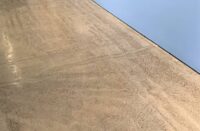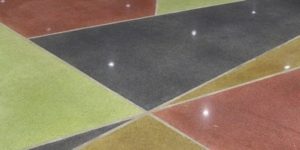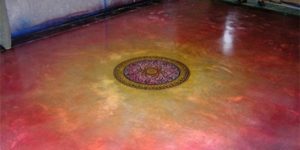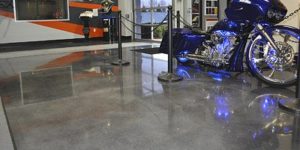
In my first column I had the opportunity to discuss how to produce a proper “scratch pattern.” In this issue I will focus on producing graphics which can either highlight your polished concrete or become the focus of your floor.
Graphic design can be produced before or after the full curing of the slab, utilizing saw cuts, specialty tape, stamping or stenciling. In this article we will focus on the methods used following a full cure, in conjunction with acid stains and acetone-based dyes. These stains and dyes can be applied to gray, white and integrally colored concrete.
You will note the conspicuous absence of overlays. To date no overlay works
with a densifier to allow the creation of a long-wearing, densified polished floor. The polymers that provide for the flexion and flowability of a self-leveling overlay interfere with the cement and densifier. If you require a self-leveling overlay you will be forced to utilize a topical sealer to protect your work.

Why do acid stains, and more recently some dyes, work with a densifier without requiring a sacrificial sealer? When you read an acid stain manufacturer’s disclaimer, it will state that their product will last as long as the wear surface to which it is applied.

So if you simply clean the surface, and then apply the acid stain, you are counting on the weakest part of the slab to protect your acid stain or dye application. This promotes the opportunity for guaranteed failure, unless you are willing to continually reapply a sacrificial sealer coating on the surface.
When you combine the integration of acid staining with proper grinding, polishing and densifying, you eliminate the need for a topical sealer. When you think about it, the acid stain and dye manufacturer is concerned with “the wear surface,” and a densifier like RetroPlate has been shown to increase the floor’s abrasion resistance by up to 400 percent. It doesn’t take a giant leap of faith to know which method will provide your customer with the best-wearing floor — and the floor with lower maintenance costs. In fact, a polished and densified concrete floor has one of the lowest life-cycle costs of any flooring option available today.

Acid stains and dyes
When we talk about acid stains and acetone-based dyes, what are we talking about?
Acid stains are actually water-based liquids that have two main components in addition to the water, acids and metallic salts. The acid component opens up the pores of the concrete through etching to allow the penetration of metallic salts.
he metallic salts then chemically interact with the calcium hydroxide (free lime) within the cement to produce a permanent color change in the affected concrete. The colors will be earth tones, with a mottled, variegated appearance replicating marble. (Note: Blues and greens should not be used in areas of constant or standing water, as they will oxidize toward a black color.)

In the past, topical stains and dyes had generally failed in conjunction with polished concrete because unlike acid stains, they do not create a color change through chemical reactivity. Today we are starting to see manufacturers, such as Colormaker Floors, successfully formulate their products to achieve penetration of the dyes into the surface. In the case of this type of dye, as the acetone carrier flashes, the size of the dye’s molecular structure allows it to be driven into the surface of the prepared slab. Think back to what the densifier does for the concrete, and again we can see why the “walk-off” has been eliminated. The dyes are bringing new excitement to our industry because they are capable of either being mixed to create a full palette of color, being utilized in conjunction with acid stains to produce highlighting, or being used to save projects where an acid stain did not take. Several manufacturers are also starting to produce stains that have dyes incorporated in them during the manufacturing process.

 Graphic Presentation
Graphic Presentation
When designing or laying out a graphic pattern with polished concrete, or when simply applying an acid stain or acetone-based dye to the whole floor, you must take into account the fact that you will be grinding the slab at some point, and that if you apply the acid stain or dye too early in the process, that you will end up grinding off your color. At what point you apply the color will depend on several variables: what look you are trying to achieve, what the manufacturer recommends, and more importantly, your own testing, knowledge and experience. Following are suggestions to help you ask the correct questions, allowing you to deliver the expected results:
Depth:
• Acid stain reacts more vibrantly with cream and becomes mottled.
• The more aggregate that you expose, and the less cream that remains, the lighter and more monolithic the results.
• Acid stain in conjunction with densifying produces a more translucent, natural stone appearance than an unground, topically sealed application.
Saw-cutting:
• Cutting is generally performed prior to the application of color.
• Decorative cuts are generally the width and depth of the blade thickness.
• Patience is a virtue, as is using a sharp blade. You cannot “erase” a mistake.
• Protection from concrete dust is a necessity for both health and the preservation of the customer’s space.
Stencils:

• Stencils may be intricate in design or as simple as a piece of rough-torn paper.
• When using stencils with acid stain, have the sign maker provide samples of different vinyls to ensure that the material doesn’t allow wicking of stain under the stencil.
• When using acetone-based dyes, be aware that excessive application can dissolve adhesives.
Specialty tape:
• Specialty tape (automotive pin-stripe tape works well) comes in many widths and is only limited in design by the radius you can turn.
• Do not overstretch or pull up the tape to readjust your line, as either will promote wicking. Unlike a saw cut, you have the luxury of starting with a new piece of tape if you are not happy with its application.

• Always neutralize your acid stain prior to removing the tape to eliminate color contamination of your “faux” joint.
• Your “faux” joint will be the color of your slab. Make sure that you and your customer agree on the final appearance.
• Do not leave the tape down for more than two days. It’s applied to cars for a reason.
Tips:
• Spilled acid stain, if addressed quickly, can usually be cleaned up with muriatic acid. Flush with water.
• Spilled acetone-based dyes, if addressed quickly, can usually be cleaned up with acetone and a cloth.

• Acid stains cannot be mixed like a dye, with the mixer expecting a + b = c results. They do not react like primary colors. Experiment before committing to anything. It is better to achieve variation through overlaying or highlighting with either a second stain or a dye.
• Adding “water only” generally results in weaker, more mottled colors due to a reduction in the water-to-acid ratio. This affects the opening up of the surface and the subsequent penetration of the metallic salts.















